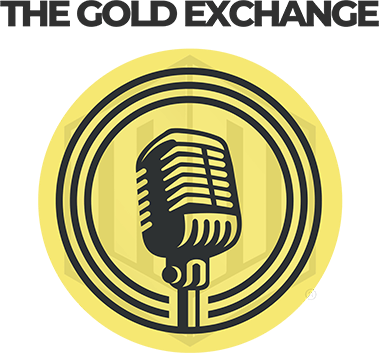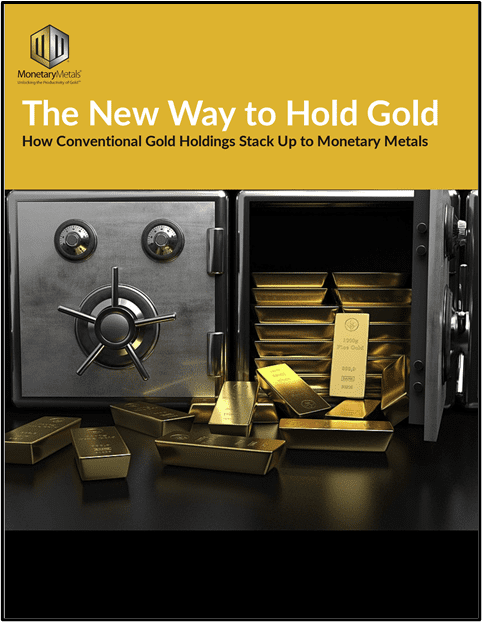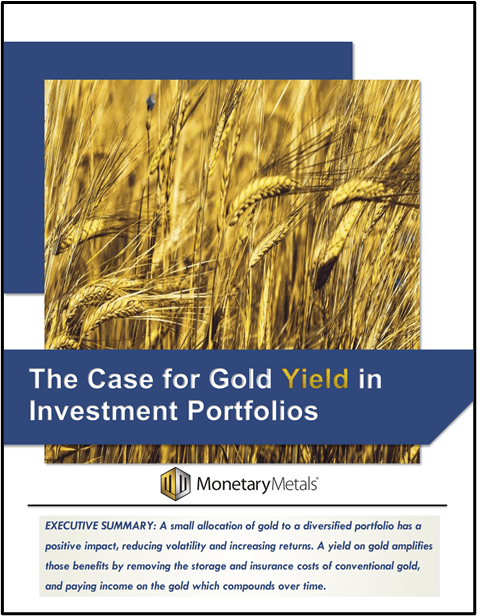Gwen Preston, the Resource Maven, joins the podcast to discuss the impacts of hiking interest rates, growing signs of market instability, and the implications for gold and other metals. Gwen also comments on the green energy revolution, different narratives for various metals, and her advice for investors during this time.
Additional Resources
The Case for Gold Yield in an Investment Portfolio
Podcast Chapters
[00:00:00]: Gwen Preston
[00:00:41]: Potential impacts
[00:02:13]: Our debt-fueled economy
[00:04:15]: Flight to safety trade
[00:07:55]: Inflation
[00:10:46]: The green energy transition
[00:13:02]: Different narratives for gold, uranium, and base metals
[00:16:26]: Seeking a range of opinions on investing
[00:17:49]: US Treasury risk
[00:20:09]: Subscribe!
Transcript:
BVN:
Welcome back to The Gold Exchange Podcast. My name is Ben Nadelstein. We are live at the New Orleans Investment Conference. I’m joined today by Gwen Preston, the Resource Maven. Gwen, how are you doing today?
Gwen Preston:
I’m doing well. How are you?
BVN:
Gwen, I want to jump right in. So most people have said at 5 % interest rates, we’re going to see a stock market crash. There’s going to be a recession. Metals, especially gold and silver will go higher. We’ve started to see the beginning of that. Do you see that we see a further push in the price of gold and silver and the stock market continues to fall? Or do you think things remain stable?
Gwen Preston:
I think that is the direction that we’re going. I don’t want to try and put an exact timeline on that because timing is always the thing, right? But I think the signs of instability in the market just keep rising. I mean, you can take a step back and look at the big picture where you can’t for a really long time have a stock market that gains 10 % a year when GDP growth is three %. That just doesn’t work. So at some point, that gap has to correct. And there’s all kinds of reasons why that… It makes sense that that should happen sometime in the next little while, right? I mean, it takes 18 months often after the beginning of a rate hike cycle for those rate hikes impacts to really aggregate. We are getting that now. You’re seeing consumer loan issues, credit card issues, auto loans. You’re seeing corporate loan junk bond yield spreads are just starting to go. The wall of debt that needs to be refinanced for small and medium companies is really dramatic. They couldn’t lock in the really long term and therefore low rate that large companies can, so that wall is coming up hard and fast.
In an economy that is so fueled by debt as ours is, impact, a rate hike cycle of this magnitude absolutely is going to come home to roost at some point. I think we’re right there at that point. Add in the fact that, sure, the Fed didn’t raise rates yesterday or the day before, but that doesn’t matter because the bond market is doing it on its own, right? It’s eased in the last few days a bit. But again, if we want to talk about big picture, there’s big picture reasons why treasury yields keep going higher. There’s a structural oversupply of treasuries. This is also about an economy, a government that is financed on deficits. Yes, there’s big things at play here that I think create significant risk of recession in the near term, and that benefits gold. Gold stocks can hesitate, step down, be sold alongside everything else in the moment of a recession or crash. But we have had many experiences, more than some might like to remember, in the last few years that remind us that gold moves first and best out of a recession. So really early in that recession, people start moving to that risk, that safe haven, and then gold stocks follow closely thereafter.
So I do think that that’s happening. You started the question asking about metals. Metals as a whole, they don’t do well in recessions because people don’t buy metals until they see confident economic growth. But that hopefully can follow on afterwards. But I am optimistic on gold in the next little while. Timing, we shall see. But it looks, the signs are definitely building.
BVN:
And let’s talk quickly about the flight to safety trade. A lot of people have said gold is actually getting a bolster here because of that flight to safety. You see geopolitical conflict, you see volatility brewing in the markets, debt like we’ve talked about. Do you also see a flight to safety in the dollar where other currencies, other central banks look weaker in comparison?
Gwen Preston:
Yeah, so that’s a really interesting… That gets to the heart of what I was just mentioning about the government’s deficit funding issues and is the treasury’s market starting to crack? The treasury’s market is the largest and most important market in the entire world. It’s not going to break all of a sudden. But if we get a failed treasury bond auction, like a truly failed one, we had a few about a month ago where the bed cover ratio was questionable and the underwriting banks had to take more of the issue than they usually would, like 18 % instead of 10 %, which is actually significant. But it wasn’t really a failed auction. They did manage to sell all of the bonds that they were trying to sell. If we had an actual failed auction, that’s the event that could tip things quite dramatically. My analogy is a tanker is turning around. It’s a very slow process for a tanker to turn around. These things do not move quickly, and so that’s just slow. But that doesn’t mean that a hurricane can’t hit that tanker and cause a sudden and cataclysmic event, right? And that’s the thing that could happen when you have structural cracks starting to develop in the largest and most important market in the world, which is what the treasury market is.
So in the moment of a flight to risk or a flight to safety, I mean, look at the gas war as an example. It’s a classic geopolitical event that prompted people to move to safety. Gold got a benefit, and initially people started buying T-bills because treasuries are a classic purchase in a moment of risk. But that purchase of T-bills only lasted a day and then yields started to go up again. T-bill prices started to go down because of the structural issues with treasuries. This is a real mentality shift in the market around safety and security. What are treasuries relative to safety and security right now? That’s a question that is unanswered. It is changing. It’s changing because there are fewer and fewer buyers for treasuries. Again, biggest market in the world. I’m not saying that suddenly there’s no buyers, but a bunch of the really big buyers for a long time, even including US banks, who are seeing capital flight because people are putting their own money to work elsewhere, they’re not buying as many treasuries. Of course, China is not buying as many. Russia is not buying any. Japan isn’t buying anywhere near as many.
They have been a hugely important buyer of treasuries, but they’re operating their whole yield curve control differently, and that means that they’re not buying anywhere near as many treasuries. I think that the risk move, the safe haven move will still involve treasuries. And so gold will still get some boosts initially because habits are hard to break. They’re called that for a reason. But we get already in the last month with the gas conflict, have seen how that is changing. And that for those of us who are interested in gold, is interesting because of course, gold and real rates yields have almost always moved very, have stayed very tightly inverted, right? So gold moves against real rates. But that long standing relationship may well be breaking right now because of all of these structural changes. So It was quite a rambling answer to a short question.
BVN:
And now let’s talk about another structural question here. We had decades high inflation in the United States. Other countries, again, much worse as well. Inflation has cooled, according to the CPI. Do you see inflation being tamed by the Fed? Do you think inflation came from somewhere else and do you think it’s gone for good or it’s waiting to rear its ugly head?
Gwen Preston:
It’s a good question. I mean, it certainly has come down. Did it come from the Fed? Sure. It came from everything that has happened with money in the last decade, and that seems like I’m just being too general to be useful. But you go back to the great financial crisis and then where the answer to the crisis was to inject a lot of money into the system. And then we had another crisis come up in the form of a pandemic, and the team at the Fed and the government just doubled down on that playbook, tripled down on that playbook, right? And so the injection of capital into the system was dramatic, and that makes a difference. When you inject a whole bunch of money into the system, it’s just like basic supply-demand dynamics with a lot of complicated layers on top, a lot of detail, but really you put a whole bunch more money into this, you put a whole bunch more of something into the system. The value of that something goes down. That’s what inflation is, right? And so, yes, it came from those moves. Those are being undone to some extent. This rate hike cycle is part of it, but there’s still a lot of money out there.
If we are heading into a recession, that will pull inflation down to some extent. But this is the structural issue that we’re in where I don’t see a way out of deficit spending. I mean, the US government has been reliant on deficit spending for decades, and I don’t see a way to either increase taxes or reduce spending within the system, which are the only ways to get out of our reliance on deficit spending. The underlying thing that’s driving it all, which is a reliance on spending more money than you have, and therefore needing to keep doing monetary moves to make it all possible, that’s still in play. I’m not sure exactly what’s going to happen with the inflation question. Of course, there’s all these other questions about what inflation really is and why do we bother coming up with inflation numbers that exclude most of the things that we actually spend our money on? Those are lots of things to talk about there, but really inflation is not the hugely risky thing that it was a year ago. It absolutely is still in play. Debt is the bigger question. We’ll see. Inflation at this point, I think, will be more battered around by the recession set up than being the creator of the problems.
BVN:
And let’s pivot now to a question about the Green Energy Revolution. There had been a lot of talk about ESG, green energy. We’re going to convert our economy from an oil based fossil fuel economy to a green, sustainable economy. Do you think that that argument and that narrative is more prevalent than ever? Or do you think we’ve actually seen a pivot away from that question?
Gwen Preston:
I think it’s just been put on pause, actually. So the green transition is a transition to building in a different way. So when we create new infrastructure, there is now a lot of emphasis on making it in a different way that uses less carbon, that produces less fossil or carbon emissions, relies less on fossil fuels. It’s a different way of building. But when you’re in a state where you’re not sure, you’re not confident that there’s a lot of building ahead, you’re not confident that we’re going down a path of significant economic growth, then that’s not what investors are thinking about. You’re not thinking about, Oh, how do I benefit from the new way to build?, unless you’re thinking about building. And I mean, it’s the same for the metals argument in general. Yeah, we’re facing a shortage of copper and nickel and zinc and metal, a lot of significant metals in the next few years. Mines aren’t producing enough to meet demand, especially because demand is expected to keep getting higher and higher and higher because everything, the new way of building, the green way of building, uses a lot more metal. But no one’s buying.
No investors are interested in that narrative because investors aren’t thinking about growth. And so that’s all fine. That’s all normal investor logic. I think we need to… That will not change until we get to the point where investors are looking ahead to and want to position for economic growth because they’re confident that that’s the path on which we are headed. We need to get through whatever gets us to that. Is it a soft landing? Possibly. Is it a recession and then a reset of some form? I think that’s more likely, but I think we need to get through that moment and then start looking ahead to economic growth. And then I think this green transition opportunity will come back because I don’t think that people have decided suddenly that we should go back to oil. I just think that it was all put on pause because that wasn’t the focus for investors.
BVN:
Now I know a lot of investors have questions about the different types of metals. There’s copper, there’s uranium, there’s the precious metals. How do you see the difference between the metals? Is there a different narrative for each metal? Or as a whole, do you see metals and commodities doing much better in the future?
Gwen Preston:
So the three that you listed there are good examples. There’s basically three baskets. If I just want to speak about metals, I’m not going to talk about commodities. That’s obviously a very, very big arena. I’m just going to speak about metals and that’s my area of expertise. There’s really gold, silver to some extent, but really gold, uranium and base metals. Let’s just put them into those three categories. Gold is doing its own… Is charting its own path, and always does. When there’s a broad metals bull market, gold will often participate alongside. Even though its true drivers are different, it will often just participate alongside a broad metals bull market. But gold does not need a broad metals bull market to go because I just talked about how metals don’t go unless we see economic growth. Gold loves to perform in a recession. Those are different things. They’re actually polar opposites. So gold is going to respond to risk and needs for safety. It’s going to respond to… I mean, that’s its main driver right now. It’s also going to respond to central bank buying. This is de-dollarization. This is de-globalization. These are big issues that have long been arm-wavy, future-facing things that are now suddenly happening in real time.
I really love this chart that there is of central bank gold buying. The thing that I love about it, sure, central banks have been buying a lot of gold, and I think that really explains why gold has done well despite forces that should suggest it shouldn’t have done as well in the last year. But what I like about the chart is it’ll show disclosed. The central banks that say to the World Gold Council, Yes, you can tell everyone that we bought gold, that’s fine, versus undisclosed, the central banks that are like, Yeah, we’re buying gold, and we’ll tell the World Gold Council that we’re doing it, but you’re not allowed to say who we are. The undisclosed gold buying is now the majority of the massive bar. That just is clear proof of how a whole bunch of these bricks and bricks-plus nations are quietly but significantly accumulating gold, and they don’t want to be loud about it. They don’t want the whole world to know, but they are positioning for a deglobalized, dedolarized world. So gold is doing its own thing. Gold can operate on its own. Uranium is also doing its own thing.
Uranium often can move alongside other metals, but nuclear utilities can’t let their reactors run dry. That’s what causes meltdowns and disasters. And so uranium, I could talk for a whole hour about uranium. I promise I will not. But uranium can move to its own beat as well. Its price is up 50 % in the last four months. I think that move is only just getting started. I think there’s a lot more leg in this uranium market. It clearly is moving on its own time frame outside of base metals. The rest of the base metals complex isn’t going to move until we are on a path towards confident economic growth. Once we’re there, I think the upside opportunity is dramatic, but there are three different timelines for those three baskets of metals. Understood.
BVN:
And now I want to ask you, other than subscribing to the Gold Exchange podcast, subscribing to the Resource Maven, what are some indicators, newsletters, articles, books, movies, something that people should watch, understand, listen, or read to get a better understanding not only of where you’re coming from, but what they should be looking for in the future for markets as well as other things in their lives.
Gwen Preston:
What an interesting question. On the gold front, one thing that comes to mind is there was that really great movie made lately called Gold, narrated by Iras Ed… I can’t say it. There we go. I knew I was going to mix up the… Yeah, so not dramatically educational, but very well done and takes a really nice look through the history of gold and its role. I think that’s a really nice intro for people to the gold space. I think rather than trying to tell people particularly where to look, I just caution everyone to not go down any particular rabbit holes. Try to take a broad look at… Don’t listen to one voice. I think that’s the main reason I don’t want to name particular things. Don’t listen to one voice because it is very easy for individuals to get too focused on one aspect and neglect other forces. I think make sure that you’re listening to a range of opinions. I know that I ensure that my social media feeds and my inbox is… I actively seek out opinions that are contrary to what I naturally think. Then I read and consider those probably more than the data that’s coming in in support of my own ideas.
Just make sure you’re getting a range of opinions because going down a rabbit hole is unlikely to work well in your favor as an investor.
BVN:
So in the description of the video, we’ll put our how not to think about gold field guide. We go through some things where a lot of popular sentiments say, Hey, this is how you should think about gold, or maybe this is how you think about gold. We wrote a free field guide explaining maybe this is how you should not think about gold. So we’ll put that in the description as well. I want to ask you one last question before I ask you where people can find more of your work. What’s a question I should be asking other guests of the podcast? We’ve had some say, ask about other central banks, not just the Fed. We’ve had some say, ask about the Euro dollar market. Other guests have said, please ask about the debt ceiling, and if you think that will be a problem. So what’s a question I should be asking other guests of the Gold Exchange Podcast?
Gwen Preston:
I think particularly at this conference, what I love about this conference is the depth of macroeconomic US knowledge. So I would love to get perspective on real timelines for this US Treasury risk. I see cracks forming in that market. And I know that sounds very technical and boring, but it is the… I’ll say it again. But treasuries are the most important market in the world. If it actually is starting to crack and if we are facing a moment where that hurricane could hit that tanker, that would have a very dramatic impact and it would impact all investors in all arenas. I would want their opinions on whether there is a risk that the treasury’s market will run into a storm in the near term, or whether that is one of these concepts that’s having its moment of overblown attention and will actually pass.
BVN:
Final question. Where can people find more of Gwen Preston and the Resource Maven?
Gwen Preston:
Thank you for asking. I write newsletters about what I’m doing with my portfolio, a particularparticularly in the metals and mining space. So if you like junior mining investing or want to learn more about investing opportunities in the evergreen space, in the green transition, or if you’re an accredited investor who likes financing opportunities in mining, those are the three newsletters that I write, and you can find them all at resourcemaven.ca.
BVN:
Gwen Preston, thank you so much for joining the Gold Exchange Podcast.
Gwen Preston:
Thank you for having me.
Additional Resources for Earning Interest in Gold
If you’d like to learn more about how to earn interest on gold with Monetary Metals, check out the following resources:
In this paper, we look at how conventional gold holdings stack up to Monetary Metals Investments, which offer a Yield on Gold, Paid in Gold®. We compare retail coins, vault storage, the popular ETF – GLD, and mining stocks against Monetary Metals’ True Gold Leases.
The Case for Gold Yield in Investment Portfolios
Adding gold to a diversified portfolio of assets reduces volatility and increases returns. But how much and what about the ongoing costs? What changes when gold pays a yield? This paper answers those questions using data going back to 1972.






